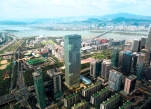Efficient Solar Facade

The architects Adrian Smith + Gordon Gill Architecture developed a revolutionary solution for the facade of the tower under construction in Seoul. Its essence is that the building is enveloped in a corrugated shell into which solar cells are built. Corrugation technology or the formation of folds is known for a long time. In construction industry is used to create stiffeners by bending a sheet made of metal, cardboard, cloth, etc., which improves the strength characteristics of materials and their ability to resist deformation. But in this case, the corrugated façade is used for another purpose.
AS+GG is collaborating with the engineering firms Thornton Tomasetti and Environmental Systems Design, as well as with the local firm Chang-Jo Architects. The new head office of the Federation of Korean Industries (FKI) will be a simple and graceful symbol for Seoul. This high-performance, highly efficient, energy-saving building will provide comfort to both tenants and visitors alike. Employees and tenants will enjoy rich green spaces and natural lighting. Sustainability was a goal for both client and architect, and the architects figured out how to exploit a Korean energy subsidy to justify the added costs of the BIPVs. Solar power can be sold back to the grid at seven times the price of conventional power, up to a certain amount. AS+GG figured out that integrating panels into the building’s two sunniest sides could produce that quota. “This is the first time BIPVs have been used in a tower with this degree of efficiency,” Adrian Smith told. At more than 240 meters, the new head office building for the Federation of Korean Industries (FKI) will be a major new addition to the skyline of Seoul, South Korea. AS+GG won an international competition to design the tower in 2009.
Full version you can download here
 Materials provided by Adrian Sm ith + Gordon Gill Architecture
Materials provided by Adrian Sm ith + Gordon Gill Architecture


